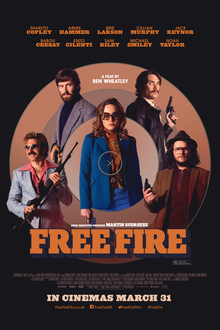In 1970s Boston, a negotiator (Armie Hammer) and liaison (Brie Larson) broker a deal between two members of the IRA (Cillian Murphy and Michael Smiley) and a South African arms dealer (Sharlto Copley) in a warehouse. Tensions rise however, when the weapons turn out to not be the M-16s that were ordered, and aggressions reach boiling point when one of the the IRA associates (Sam Riley) is revealed to be in a violent feud with one of the dealers’ men (Jack Reynor). Soon, the situation escalates to the point everyone is involved in a bloody free-fire match, each determined to get away with the money, weapons, or vengeance.
This is a consciously stylistic movie, not just in its content, but how it plays out in real time and in only one setting: the warehouse where the deal’s supposed to take place. Neither of these characteristics are new to movies and it’s always a risk to employ them because of the restrictive narrative problems they pose. Thus when one of these devices succeeds, it’s all the more impressive. And it can certainly be said that Free Fire keeps your attention through using these devices better than some other films. Of course that being said, this is no 12 Angry Men. In fact it’s a lot closer in its violence, set-up, and even musical choices to Reservoir Dogs.
This movie really has a streak of a Tarantino or a Guy Ritchie film, if not in just its stylized presentation than in its dialogue, which is peppered with that same kind of dark comedy Ritchie is known for. Characters make fun of each other constantly, and trade quips and humourous taunts amid the gunfire. And while this writing for the characters can be very entertaining, the writing for the plot isn’t as strong, with developments added purely to lengthen and justify the runtime. The escalation to the shoot-out is a little too ridiculous and contrived -it’s purely an excuse to get to the free fire. There are a couple new objectives and new characters introduced into the fire-fight who are completely pointless and you can see script beginning to wear thin in these moments. Smaller issues can hurt the movie too. Though it’s kind of an interesting quirk that before anyone dies, everyone’s been shot at least once, it does strain believability how well they can continue to function with so much blood loss. There’s an explanation of sorts, but one guy is shot at least four times and manages to outlive a number of others.
This is a good cast though. Brie Larson’s better here than she was in Kong: Skull Island, and Armie Hammer’s not bad either. The best performance is probably Cillian Murphy, but he’s usually very good. And I’m glad to see Michael Smiley, an actor who’s had minor roles in tons of British movies and television, given a decent-sized part in this film. Jack Reynor is the only Irish actor in this film playing an American, but he does so alright. Enzo Cilenti and Noah Taylor also appear in this. The only performance that doesn’t work is Sharlto Copley, who plays his part too well to the point you can’t stand his character. It’s overacting an annoying character to the point you’re just waiting for him to die. And that’s saying something when the movie’s got a full cast of horrible people. No one’s really that likeable, and so you’re more curious than invested in who lives and who dies. The two Irish guys are perhaps the least awful, until you remember they’re with the IRA and they immediately become despicable again.
But this is an action film and in many respects, delivers what it needs. There’s really never a dull moment when something’s not happening. Wheatley, whose previous credits include High-Rise and Peter Capaldi’s first episode of Doctor Who, is also capable of injecting some creativity into the scenario, and an energetic momentum to even the ceasefire moments. And during the banter there are a few good laughs, some fun wit, and even a few really good physical gags.
Free Fire is a movie whose title tells you everything, and if the idea of people shooting at each other for almost ninety minutes catches your interest, you’ll like this movie. For me, I don’t think it quite sustains its premise, has some shoddy plotting, and borrows a little too heavily from other directors’ styles; though I appreciate seeing risks like this taken, even if they don’t always pan out.

Comments
Post a Comment